With businesses and organisations seeking a return to operations in what is being referred to as the ‘New Normal’, many manufacturers are offering technologies and devices designed to ease the resumption of activities in the face of COVID-19.
As a growing number of businesses and organisations seek a return to operations following the lockdown and disruption linked with the COVID-19 pandemic, a number of manufacturers are offering technology-based devices and systems to aid in meeting the various requirements. While technology does not offer a silver bullet for the problems faced, it can help with compliance issues during a return to some degree of normality.
One of the often-quoted uses of technology is thermography and infrared temperature detection. Where devices have the ability to detect temperatures with a high degree of accuracy, these can be deployed to check for people with fever. While not every person infected with COVID-19 will have a high temperature, and not every person with a higher temperature will be infected, the information can help with filtering people.
Video analytics also has a role to play, with possibilities to enforce social distancing by alerting operators if people are too close together or congregating in large groups. Mask detection is also possible, according to some IVA suppliers.
Access control has also come under the spotlight, and can play a role in occupancy management, controlling footfall and logging who in a corporation has been in a confined space with others.
There are also some technologies which are predicted to fall out of favour. There will be a swing away from contact-based technologies, with more acceptance of non-contact options. For example, a report from ABI Research predicts a revenue drop of US$2 billion over the course of 2020 for products which use contact-based biometrics. The report claims this will be balanced by an upsurge in adoption of non-contact identification and tracking technologies, including those which make use of artificial intelligence algorithms and face recognition technologies.
Technology has a role to play in ensuring guidance is adhered to, and Health and Safety policies are followed. The following products and solutions can assist businesses and organisations seeking a return to operations.
Security & Safety Things offers On-Camera Apps
Security & Safety Things has announced the commercial availability of a number of new smart IP security cameras, from a variety of vendors, that leverage the Security & Safety Things open and secure IoT platform. This new generation of security cameras will operate using the free S&ST camera operating system, which enables the cameras to run multiple AI-enabled applications in parallel.
The apps automate the analysis of video data to produce valuable operational intelligence for business optimisation as well as providing easy-to-deploy tools that can aid in re-opening measures after the COVID-19 pandemic.
‘Organisations of all sizes need flexible solutions that enable compliance with constantly changing pandemic health and safety mandates and provide future value to ramp up and optimise their ongoing business operations,’ states Hartmut Schaper, CEO, Security & Safety Things. ‘Companies can now deploy cameras, running the S&ST OS and using a selection of apps from our Application Store, to detect the absence of facial coverings in a retail environment. Tomorrow, the same camera can help that retailer to optimise merchandise placement based on store foot traffic, in one store or throughout the enterprise, along with further optimisations.’
Qisda/Topview will be the first camera manufacturer to launch a camera running the S&ST OS, followed by AndroVideo, who will also start shipping its S&ST enabled cameras in Q2. Bosch is making its INTEOX camera line available as of July, followed by Vivotek and BSTsecurity in Q3. The first devices from Hanwha Techwin that run the S&ST OS are expected to be commercially available in Q4.
The free Security & Safety Things OS is built on the Android Open Source Project (AOSP). It leverages the expanding processing and analytic power of modern IP cameras to exponentially increase the amount of operational intelligence that can be mined from traditional surveillance footage.
The applications that can be installed on these cameras, both in an on-premise as well as a remote setting, are created by highly specialised third-party developers and are available through the platform’s open Application Store. It already features more than 50 applications from more than 35 developer partners, with more than 30 additional apps expected to be added to the store in the future.
Genetec assists with Occupancy Management
 As many business and organisations get set to start reopening, the need to enforce physical distancing measures is critical. To help monitor occupancy levels and ensure compliance with regulations, Genetec offers an Occupancy Management Package.
As many business and organisations get set to start reopening, the need to enforce physical distancing measures is critical. To help monitor occupancy levels and ensure compliance with regulations, Genetec offers an Occupancy Management Package.
The Occupancy Management Package includes analytics and reporting tools that enable users to leverage their security system to count the number of people in a store or similar business area, visualise data, and alert employees when occupancy limits are reached.
Audit reports can also be easily produced to demonstrate compliance with physical distancing regulations. Users can define policies that adhere to local guidelines for occupancy, and mobilise their operations to limit the risk of transmission.
Live occupancy data is displayed in clear, graphical ways. When occupancy limits are approaching limits, employees who are responsible for monitoring the situation can receive alerts on a mobile device, via email, or on the Security Center dashboard so they can take appropriate action.
Rob Borsch, Practice Leader, Retail and Banking, at Genetec, stated, ‘In order to enforce strict occupancy rules, users will need to do more than just count the number of people entering their premises – they will need to know how many people are inside a space at any given moment, continuously monitor this data, and be able take action when thresholds are reached.’
Videx sees increased focus on Access Control
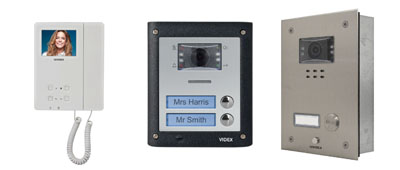 The COVID-19 pandemic has affected healthcare and medical organisations, and operational management approaches have changed across the sector. Videx has seen a rise in demand for intercom systems. The contagiousness of the coronavirus, coupled with the higher volume of patients admitted to hospital with the disease, has increased the need to secure specific wards and departments.
The COVID-19 pandemic has affected healthcare and medical organisations, and operational management approaches have changed across the sector. Videx has seen a rise in demand for intercom systems. The contagiousness of the coronavirus, coupled with the higher volume of patients admitted to hospital with the disease, has increased the need to secure specific wards and departments.
At the same time, GP practices, pharmacies and other healthcare organisations have also reconsidered their entry provision to minimise the risk of the virus spreading.
IP based intercoms are popular due to the flexibility and ease of installation. The Videx IP kit comes as an expandable system with multiple entrance and call points that can be customised to suit the needs of any building, whether an A&E department, outpatient unit or medical centre.
IP-based systems don’t require dedicated wiring infrastructure and can be used on existing networks. These networks can be shared with other technologies such as video surveillance, building management, etc..
Wrong Way Detection helps with social distancing
Video analytics can be used to strengthen COVID-19 preventative measures, according to intuVision. Wrong Way Detection in essential retail environments can be used to ensure customers follow any one-way aisle restrictions for safe distancing.
intuVision if offering Stop-the-Spread analytics tailored for controlling the occupancy levels in stores and monitoring crowd density and face mask usage in public areas to ensure essential businesses can safely operate during COVID-19.
Wrong Way detects customers who are not following the marked directions; upon detection, the software generates warnings and alarms, as well as logging instances of non-compliance. The alarm conditions and follow-on actions are fully configurable, not only with direction, but also distance and time travelled in the wrong direction.
Depending on the use case scenario, intuVision’s output triggers and Review Application can be used to meet a range of customer requirements. Immediate action can be taken to remind customers, such as triggering audio alarms or triggering digital signage.
Digital Barriers provides fever scanning solution
Digital Barriers has announced the release of a real-time remote fever scanning solution that adds remote monitoring. Fever scanning cameras help safeguard frontline workers against potential infection.
The addition of Digital Barriers’ remote monitoring enables this to be carried out without the need for close human contact, thereby cutting the risk of transmission.
Providing both a thermal and HD optical camera, Digital Barriers’ EdgeVis Live technology ensures reliable real-time standoff temperature detection and profiling, even in locations with poor bandwidth and network connectivity. The thermal camera analyses body temperature, and sounds an alarm when a specific temperature threshold is exceeded.
The solution provides users with a means of quickly identifying staff and customers who show one of the signs of an infection.
Digital Barriers’ remote fever scanning solution can be deployed as a standalone system or as part of a networked solution, linked to a centralised command and control location.
Zak Doffman, CEO at Digital Barriers, stated, ‘Protecting key workers has never been more vital and we’re pleased that EdgeVis Live, our resilient live streaming capability, can play a crucial role in remotely identifying potential carriers of any likely infection, thus safeguarding those we are relying on most, as well as the wider public.’
Hanwha Techwin cites advantage of video analytics
Hanwha Techwin Europe has stated the latest advances in video surveillance may be able to help businesses safely reopen after the restrictions associated with COVID-19 are eased. As the number of people testing positive for COVID-19 reduces, thoughts are turning to how businesses will be able to safely reopen. Inevitably, social distancing rules will have to remain in place and this is likely to mean only a specified number of people will be allowed to be in a controlled area at any one time.
Video surveillance cameras which are preloaded with people counting video analytics can provide real-time information on the net number of people on the premises at any particular time, as they are able to simultaneously count both people entering and leaving a premises. The data can be displayed on smartphones, laptops and PCs, to provide managers with an early warning if permitted numbers are close to the limit.
Although developed to help retailers gain an understanding of customer behaviour, video analytics capable of identifying occupancy levels provide a powerful tool to identify if too many people are congregating in specific areas.
AI-Crowd video analytics, developed by Hanwha Techwin’s technology partner, A.I Tech, is able to provide an estimation of the number of people present in crowded areas where they might be expected to move slowly or stop, whilst AI-Overcrowd will generate an alert if the occupancy of an area exceeds a specified threshold.
As with people counting analytics, this solution can be quickly deployed and used ‘out-of-the-box’, as it can also run onboard cameras, which have open platform chipsets.
Many cameras will support two-way audio and as such, will enable operators to communicate with visitors that they need to move out of the area.
In addition to these specialist video analytics applications, a large number of IP network cameras from Hanwha Techwin include various license-free analytics. The latest generation of Wisenet cameras, for example, are equipped with a suite of Intelligent Video Analytics (IVA), which includes enter/exit direction, tripwire and face detection.
Combinations of these various forms of video analytics can be configured to form a cost-effective digital barrier to prevent entry into prohibited areas.
TDSi launches Track and Trace module
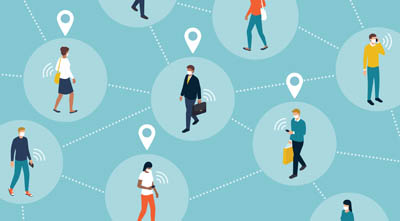 TDSi has announced the launch of a free Track and Trace module for its EXgarde security management software. Track and Trace is designed to help organisations investigate and map the movement of people potentially infected with COVID-19, so those who have come into potential contact can isolate or seek medical testing or assistance.
TDSi has announced the launch of a free Track and Trace module for its EXgarde security management software. Track and Trace is designed to help organisations investigate and map the movement of people potentially infected with COVID-19, so those who have come into potential contact can isolate or seek medical testing or assistance.
The module has been developed in response to global requirements to help contain and fight the spread of COVID-19. Access control systems are well placed to not only restrict movement, but also to accurately record it. Track and Trace is a free download to all users of EXgarde.
The module makes detailed database enquiries, reporting movements of specific individuals as they pass through secured access points. It gives an accurate account of other individuals who have used these access points. This data helps users assess and test those in potential danger of infection, as well as enabling the cleaning of relevant areas and the introduction of isolation measures where appropriate.
One part of containing the COVID-19 pandemic is tracking infections and preventing further spread. Smartphone apps for tracking require people to actively participate. Electronic access control systems can track anyone who enters a secured area using a system credential.
Track and Trace can be used at a variety of premises,ranging from SMEs to large multi-national Enterprise applications.
Eagle Eye supports dual spectrum cameras
 Eagle Eye Networks has announced enhancements to the Eagle Eye Cloud VMS include support of dual spectrum cameras used in elevated temperature detection. Interest in the use of dual spectrum cameras with integrated analytics for locating faces and measuring temperature has increased as users look to reduce the spread of COVID-19.
Eagle Eye Networks has announced enhancements to the Eagle Eye Cloud VMS include support of dual spectrum cameras used in elevated temperature detection. Interest in the use of dual spectrum cameras with integrated analytics for locating faces and measuring temperature has increased as users look to reduce the spread of COVID-19.
The Eagle Eye Cloud Video platform supports a range of thermal cameras. However, some newer cameras operate simultaneously in the visible spectrum and the thermal spectrum, combine information from both spectrums to obtain temperature readings more accurately on the human face. These cameras output specific analytic information which has been integrated into the Eagle Eye Cloud VMS.
Eagle Eye has tested and integrated a series of thermal cameras at diverse price points, all with varying levels of accuracy. Some of the more accurate cameras utilise a blackbody calibration unit in the field of view to provide a temperature reference point.
VCA Technology allows tracking of individuals
VCA Technology has released a software tool to help retailers manage footfall and occupancy in their stores. The software is able to analyse shoppers’ movements in, out and around the store by simply mapping their gait. By mapping this nature of movement, retailers will be able to differentiate shoppers whilst not infringing on their privacy.
With retailers needing to manage social distancing within stores for the foreseeable future, this solution enables them to monitor the store and apply rules to trigger alerts. This is especially crucial in queue management, which would need rigorous manual oversight. Alerts can help focus attention to where it’s needed; thereby keeping staff safe.
COVID-19 has rewritten the rules of retail, and social distancing policies will not disappear when lockdown ends. The gait analysis technology helps retailers manage this by implementing one-in, one-out policies, even in larger stores. Gait analysis will help manage this, regulating occupancy in a more efficient way.
Siemens offers temperature monitoring
Siemens Smart Infrastructure has launched Siveillance Thermal Shield, which measures the body temperature of a person seeking to access a building and enables the results to be integrated into the video and access systems of corporations. Thermal imaging cameras are used to measure body temperature at a distance of up to two metres. If the screening indicates an elevated body temperature, a second reading must be taken using a medical thermometer to confirm the finding.
This solution integrates the third-party screening camera with the Siveillance Video platform and other security systems from Siemens. Measurements can be seamlessly integrated into the workflow of solutions.
Using Siveillance Thermal Shield at the entrance to a building offers a quick and easy way to screen employees as part of routine access control procedures.
To ensure accuracy, the cameras measure the body temperature near the eyes. A positive result triggers acoustic and visual alarms, allowing secondary checks to be carried out.
Vodafone offers heat detection
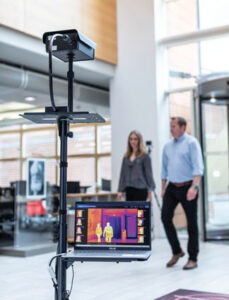 Vodafone UK, in partnership with Digital Barriers has launched a Heat Detection Camera to help organisations get back to work safely during the COVID-19 pandemic. It combines thermal imaging and Vodafone’s IoT connectivity to screen the temperature of people as they enter buildings.
Vodafone UK, in partnership with Digital Barriers has launched a Heat Detection Camera to help organisations get back to work safely during the COVID-19 pandemic. It combines thermal imaging and Vodafone’s IoT connectivity to screen the temperature of people as they enter buildings.
Each camera can check the temperature of 100 people per minute; thermal images are streamed to a laptop or mobile device and instant analytics provide a discreet alert that a person may have a raised temperature. Alerts can be further investigated using standard clinical evaluation methods.
The IoT solution provides reliable and secure connectivity and enables standalone installation with no additional IT requirements.
The camera incorporates both thermal and HD cameras that deliver reliable, real-time body temperature screening accurate to within +/- 0.3 degrees Celsius, according to Vodafone.
VIVOTEK supports social distancing
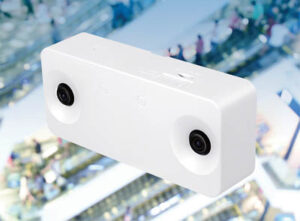 During the COVID-19 pandemic, social distancing has become a standard intervention, proven to be an effective way to reduce the spread. Retail sectors have adopted practices such as limiting the number of in-store customers, in-store social distancing markers, investing in protective equipment, and increasing upper-limits on contactless payments.
During the COVID-19 pandemic, social distancing has become a standard intervention, proven to be an effective way to reduce the spread. Retail sectors have adopted practices such as limiting the number of in-store customers, in-store social distancing markers, investing in protective equipment, and increasing upper-limits on contactless payments.
AI-based IP surveillance solutions can reduce the load on manual management while also mitigating the risk of both employee and customer infection. VIVOTEK has implemented AI technology into its Crowd Control Solution. This includes an edge-computing stereo counting camera, PoE switch and network video recorder. The solution is designed to enable businesses to comply with social distancing regulations and maintain maximum occupancy.
Geutebruck adds pandemic solutions
 Geutebruck has expanded its technologies to include body temperature measurement, detection of face masks and counting visitor flows to enable users to adjust their protective measures to the current situation.
Geutebruck has expanded its technologies to include body temperature measurement, detection of face masks and counting visitor flows to enable users to adjust their protective measures to the current situation.
Body temperature measurement allows automatic screening, and automated face mask detection verifies compliance with policies. When connected to an access control system, entry can be blocked for those not wearing a mask.
Visitor counting and flow management is ideal for retailers who need to ensure the number of customers in their premises is limited.
Fever screening options
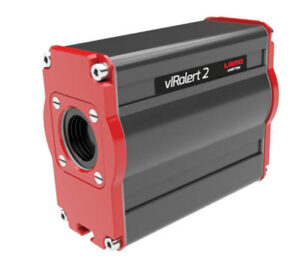 AMETEK Land has released a fever screening thermal imaging system designed for accurate human body temperature measurement.
AMETEK Land has released a fever screening thermal imaging system designed for accurate human body temperature measurement.
The vIRalert 2 fixed thermal imaging system provides an accurate and remote surface measurement of body temperature, automatically alerting the operator to elevated temperatures.
The technology calibrates the thermal image with a blackbody calibration source in real-time to provide a system accuracy of better than 0.5°C.
The vIRalert 2 system provides accurate and reliable skin temperature measurement for screening at point-of-entry into key facilities.
Morse Watchmans introduces new options
Morse Watchmans has introduced touchless facial recognition and an anti-microbial powder coating on the company’s KeyWatcher and AssetWatcher systems. The enhancements fight the spread of COVID-19 and other threats.
Anti-microbial powder coating is now a standard feature on all KeyWatcher and AssetWatcher cabinets. Designed to resist the spread of microbes, the coating retains its anti-microbial properties through regular cleanings, while providing durability and scratch resistance.
A facial recognition access option reduces the chance of cross-contamination and disease transmission.
Norbain adds COVID-19 section
Norbain SD has created a new section on its website for solutions aimed at helping businesses return to work. It comprises contactless access control, social distancing, and thermal imaging.
Jeremy Hockham, MD of Norbain Holdings, stated, ‘We’re in an ideal position to assemble a full picture of the issues being faced, and the solutions that our suppliers can provide. I strongly believe it is our duty to advise and support the market, ensuring that our customers, and their customers, find ways to help us all get back to a normal, albeit new normal, way of life.’



